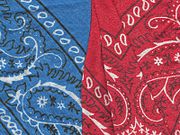******
Paisley or paisley pattern is an ornamental design using the buta (Persian: بته) or boteh, a teardrop-shaped motif with a curved upper end. Of Persian origin,[1] paisley designs became very popular in the West in the 18th and 19th centuries, following imports of post-Mughal Empire versions of the design from India, especially in the form of Kashmir shawls, and were then imitated locally. Although the fig- or almond-like form is of Persian origin, its English name derives from the town of Paisley, in West Scotland, a centre for textiles where paisley designs were produced.[2]

ペイズリー柄のバンダナ
ペイズリー (paisley) は、模様(文様)のデザインの一種。衣類、壁紙、カーテン、ソファー、ネクタイなどの装飾に使われる。
19世紀にイギリスのペイズリー市でこの柄の織物が量産されるようになり、模様は生産地の名前を取った「ペイズリー」と呼ばれるようになった。日本語では松毬(しょうきゅう)模様と訳され[1]、勾玉模様とも言われる。目次 [非表示]
1 模様の特徴
2 名称
3 歴史
4 脚注
5 参考文献
「ペイズリー」の名称が定着する以前、インドでは「ブータ」「カルカ」[15]、イランではペルシア語で「灌木」「茂み」を意味する言葉である「ボテ(Boteh)」と呼ばれていた[16]。中国語では「豚のハム」を意味する「火腿紋」と呼ばれている[17]。


沒有留言:
張貼留言